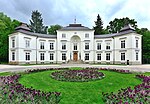Ujazdów, Warsaw

Ujazdów (pronounced OO-yaz-doof) is a prominent neighbourhood situated in central Warsaw, the capital of Poland. It is the southernmost part of the Downtown (Śródmieście) district, next to Solec and historical Frascati. The main thoroughfare passing through the neighbourhood is Ujazdów Avenue; the Chancellery of the Prime Minister of Poland, the Foreign Ministry and the Belweder Palace are located on or in the vicinity of the street. Ujazdów is an affluent neighbourhood, with villas, palaces and parks comprising most of its area. The most notable landmarks are the Łazienki Park and Palace on the Isle, the 18th century summer residence of Poland's last monarch Stanisław II Augustus.
Excerpt from the Wikipedia article Ujazdów, Warsaw (License: CC BY-SA 3.0, Authors, Images).Ujazdów, Warsaw
Myśliwiecka, Warsaw Śródmieście (Warsaw)
Geographical coordinates (GPS) Address Phone number Website Nearby Places Show on map
Geographical coordinates (GPS)
| Latitude | Longitude |
|---|---|
| N 52.2187 ° | E 21.038 ° |
Address
Ambasada Hiszpanii
Myśliwiecka
00-451 Warsaw, Śródmieście (Warsaw)
Masovian Voivodeship, Poland
Open on Google Maps









